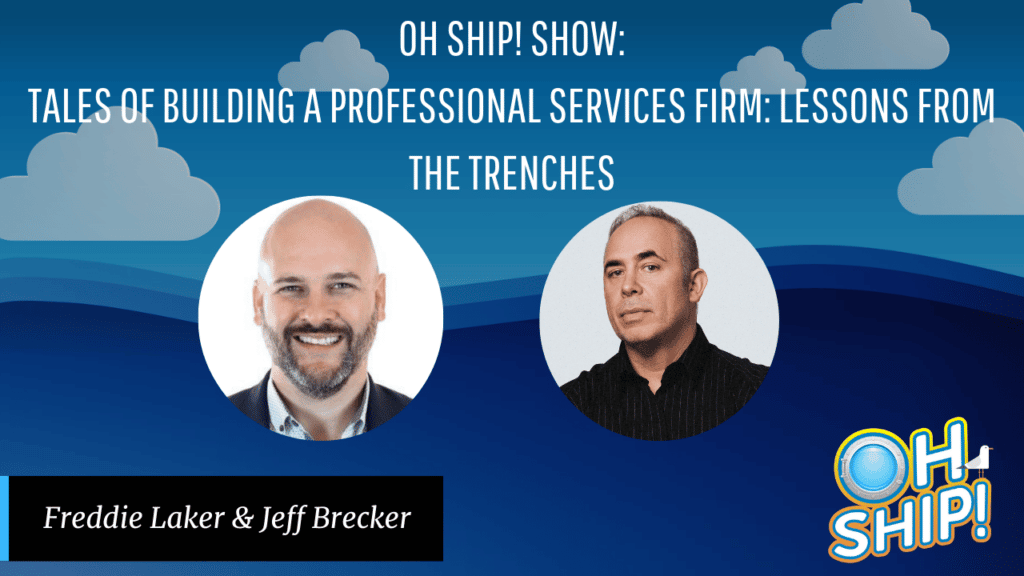Jeff shares his most pivotal advice for avoiding failure and successfully scaling—along with an embarrassing career faux pas.

With his prolific career as a leader in top-tier global agencies, Jeff Brecker has a lot to say about growing a professional services firm. He’s also worked on the client side, leading in-house agency functions, for over 20 years—giving him a rich perspective on the challenges of both brands and agencies. On Oh Ship! he discussed the ins and outs of evolving a successful agency or consulting firm in a challenging industry where failing spectacularly is all too easy.
What’s the easiest way to fail as an agency?
“The easiest way to fail is for people to think that prior success is a roadmap for future success, when, in fact it is the complete opposite,” Jeff asserts. “Everything that you’ve done and you’ve succeeded in the past has completely changed. It used to take decades and then years; now, it’s months—almost days and weeks. So things that were working previously don’t necessarily work the same in the future.”
Being flexible in your thinking can prove more challenging at scale, as you might have deeply entrenched operational processes that govern how people work, how you build creative teams, and how you set P&Ls, he says. By the same token, when working with large clients, understand their past histories and assumptions.
As you scale your agency, you gain more diversity, which benefits the caliber of ideas and approaches you can offer. However, you need to figure out how to manage that large group. (In contrast, if you’re smaller, you’re likely more nimble, but you lack that diversity of thinking.)
Critical growth points: When should you evolve, and how?
While at Digital Kitchen—his first foray into running a high-end independent production shop—Bob Greenburg called and asked him to run R/GA’s Chicago office. He was all in.
There, he gained hands-on experience building out large groups of people as they transformed from a team of 11 to 100. As growth surged, the agency built out teams with every capacity imaginable. Jeff shares key insights on evolving from a small team to a large enterprise.
Adapting structure and even purpose
“The main differentiator that happens is really when the size becomes around 50 people. You then start needing to hire managers and almost middle managers to manage the amount of work flowing into the agency, to keep it profitable,” he says. “Your leaders need to step it up and figure out how they’re able to distribute their work and their thinking and start growing the teams underneath them, vs. actively working on project-based work.”
When you reach 100, you’re most likely scaling up your capacities as an organization. If you were a design or digital company, you might start offering actual content production and media buy-in.
“Once you get above 100, you need to start to think about how you are carving it up into groups and then putting mini leaders on top of that,” he says.
How do you scale culture?
“Cultural scaling gets particularly hard around 100 people,” says Freddie. “You get to this point where you don’t know everyone.” At that point, people need to start trusting the system rather than each other—and handing over parts of their work to people they may never have met. “That’s really scary, and then if it fails, it really frays at the culture of a company,” he adds.
It comes down to really understanding what you aim to deliver, and rallying the team around it, says Jeff. “Because if you don’t have that north star, people can get lost.” They won’t produce A-level thinking if they feel disconnected from their purpose.
Of course, tech has changed the game for scaling up. Whether we’re a 5- or 100-person shop, we can connect strongly across regions.
Who has more fun—agencies or consulting firms?
The agencies—no question, says Jeff. Consulting firms tend to adopt a rigorous business school approach, whereas the agency can be more free-spirited and think about what will truly spark consumers’ interest.
He’s worked on the agency side, consulting, and in-house creative services for Kimberly Clark. What did he enjoy most?
During his time with Kimberly Clark, he worked to help it transform into a global company. In the process, he got to travel the world—and he found it incredibly exciting to grow and scale marketing and branding, not to mention culture, across multiple products and industries spanning 170+ countries. Figuring out that puzzle, and putting together global partnerships, was one of the most exciting experiences of his life.
What’s the key to building long-term client relationships?

Companies often treat agencies and consultants as interchangeable commodities rather than recognizing the vast differences between skill sets, he also notes. They often spend a disproportionate amount of time trying to find the lowest bidder. But as you hone these relationships, they’ll see the value you bring. Here’s how to do that.
Discovering their most critical needs
Really understand what’s keeping them up at night, says Jeff. Know their business objectives and what will keep them relevant in the marketplace. “How are you bringing them something they didn’t even know that they needed?” he asks.
He and his team do free-of-charge “innovation days” to invest in thinking about how clients can better approach their problems. Here, they tackle burning issues like the metaverse and blockchain—things all companies are hearing rumblings about, although they may not understand how they’ll be affected. “It’s our responsibility to come to them with ways that they can connect with that and use that to change their internal businesses. That’s the key.”
Building CMO relationships
CMOs bring in agencies based on relationships. However, the frequent CMO turnover means the agency has to rebuild trust with the replacement, Jeff says. Often they have to formally respond to another RFP. But taking the initiative to forge those relationships will pay off
“Once you have these long-standing relationships, it builds trust, and that trust builds respect because people are able to deliver, and deliver, and deliver,” he emphasizes.
Managing intense demands on time
Historically, a business would often pile work on agency creatives without much consideration of their time. But companies are starting to respect agencies’ time more. Sometimes the agency will still have late night work, or a major deadline will fall near a holiday, but this usually pertains to big projects’ turnaround dates. Just prepare for those things so you’re not surprised, Jeff urges.
How can you level up as a service firm?

“The number one piece of advice is, really figure out what your differentiator is. Because there is so much competition out there in the marketplace right now,” Jeff asserts. The big behemoths, like the Accentures of the world, are buying up the best agencies to form huge empires, so small, independent service companies need to go the extra mile—or 100—to differentiate themselves.
It’s hard to differentiate on a service level in this challenging industry, says Freddie, but you can differentiate on how and why you do it—as well as when, in terms of speed. Your portfolio can also set you apart. “Your body of work defines who you are,” he emphasizes. “To convince people to work with you is exponentially harder when your body of work is either not demonstrable, or not documented well, or frankly is not very good in general.” Take every opportunity to level up, even if it comes at a loss, and document it thoroughly. And make sure the client will let you talk about it, or it won’t be valuable to you.
Why should people look to an outside vs. internal expert?
Outside experts bring diversity of thought and talent compared to an in-house agency. “They have a very diverse approach to how they’re solving problems,” says Jeff. “A lot of times when you’re internal, you’re so focused on what that brand or company is … that it sometimes makes [you] blind to everything else that’s happening in the world.”
“There are conversations that are sometimes very hard to have inside a business,” says Freddie. “There are cultural implications, there are frankly political implications, and sometimes you’re just too close to the business. And so having someone that can come in and be that expert POV is essential.”
A faux pas that taught him a life lesson
Early in his career, Jeff was celebrating a successful campaign moment with Budweiser while working on their ad production. He went to a bar with their team, and when the drinks came out, everyone saw one Guinness among a round of Budweiser. It was, of course, what Jeff had ordered. He sheepishly drank his Guinness, but that wasn’t the end of it—with every round, they’d order one Guinness for him. There must have been twenty rounds, he says.
“That taught me two things: One, don’t drink that much Guinness, ‘cause it was brutal. But two, understand the mindset and the product. Everything that you’re doing when you’re with this client or thinking about this client needs to be around that brand and around that offering… Don’t try to be cool and do something different.”
“What you say and what you do, especially in a services industry, has a significant impact on your relationship,” he adds. “It was a life lesson.”
Find Jeff on LinkedIn or on Twitter @breckdaddy. And be sure to like and share for more powerful insights!





